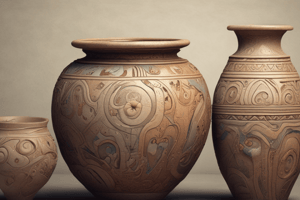Podcast
Questions and Answers
What is the origin of the word 'ceramic'?
What is the origin of the word 'ceramic'?
- From the Latin word for 'potter'
- From the French word for 'earth'
- From the English word for 'clay'
- From the Greek word 'keramos', meaning potter's clay (correct)
What is a characteristic of earthenware ceramics?
What is a characteristic of earthenware ceramics?
- It is extremely strong and translucent
- It is highly prone to corrosion
- It is fired at a relatively low temperature (correct)
- It is resistant to thermal shock
What is a benefit of ceramic materials?
What is a benefit of ceramic materials?
- They are highly conductive
- They are sensitive to temperature changes
- They are extremely hard and resistant to scratching (correct)
- They are highly flexible
What is a common application of ceramics?
What is a common application of ceramics?
What is a process used to prepare clay for ceramics?
What is a process used to prepare clay for ceramics?
What is a type of ceramic that is fired at a very high temperature?
What is a type of ceramic that is fired at a very high temperature?
What is a characteristic of ceramic materials?
What is a characteristic of ceramic materials?
What is a biomedical application of ceramics?
What is a biomedical application of ceramics?
What is a benefit of ceramic materials in industrial applications?
What is a benefit of ceramic materials in industrial applications?
What is a characteristic of porcelain ceramics?
What is a characteristic of porcelain ceramics?
Flashcards are hidden until you start studying
Study Notes
Definition and History
- Ceramics are inorganic, non-metallic materials that are created by heating clay and other inorganic materials at high temperatures.
- The word "ceramic" comes from the Greek word "keramos," meaning potter's clay.
- Ceramics have been around for thousands of years, with evidence of ceramic production dating back to ancient civilizations in Mesopotamia, Egypt, and China.
Types of Ceramics
- Earthenware: A type of ceramic that is fired at a relatively low temperature (around 1800°F), making it more prone to chipping and cracking.
- Stoneware: A type of ceramic that is fired at a higher temperature (around 2400°F), making it stronger and more durable than earthenware.
- Porcelain: A type of ceramic that is fired at an even higher temperature (around 2600°F), making it extremely strong and translucent.
Properties of Ceramics
- Hardness: Ceramics are extremely hard and resistant to scratching and wear.
- Brittleness: Ceramics are prone to cracking and shattering due to their brittle nature.
- Thermal shock resistance: Ceramics can withstand extreme temperature changes without breaking or deforming.
- Corrosion resistance: Ceramics are resistant to corrosion and can withstand exposure to chemicals and harsh environments.
Applications of Ceramics
- Art and decoration: Ceramics have been used for centuries to create beautiful works of art, from pottery to sculptures.
- Functional items: Ceramics are used to make functional items such as plates, cups, and utensils.
- Industrial applications: Ceramics are used in industrial settings for things such as electrical insulators, filters, and wear-resistant components.
- Biomedical applications: Ceramics are used in biomedical applications such as dental implants, hip replacements, and surgical instruments.
Ceramic Processing
- Wedging: A process of kneading clay to remove air pockets and make it more pliable.
- Throwing: A process of shaping clay on a potter's wheel to create symmetrical shapes.
- Hand-building: A process of shaping clay by hand to create more complex shapes.
- Firing: A process of heating clay at high temperatures to create a hard, non-porous surface.
Definition and History
- Ceramics are inorganic, non-metallic materials created by heating clay and other inorganic materials at high temperatures.
- The word "ceramic" originates from the Greek word "keramos," meaning potter's clay.
- Ceramic production dates back to ancient civilizations in Mesopotamia, Egypt, and China, with evidence of thousands of years of existence.
Types of Ceramics
- Earthenware: fired at around 1800°F, making it prone to chipping and cracking.
- Stoneware: fired at around 2400°F, making it stronger and more durable than earthenware.
- Porcelain: fired at around 2600°F, making it extremely strong and translucent.
Properties of Ceramics
- Ceramics are extremely hard and resistant to scratching and wear.
- They are prone to cracking and shattering due to their brittle nature.
- They can withstand extreme temperature changes without breaking or deforming due to thermal shock resistance.
- Ceramics are resistant to corrosion and can withstand exposure to chemicals and harsh environments.
Applications of Ceramics
- Art and decoration: used for centuries to create beautiful works of art, from pottery to sculptures.
- Functional items: used to make functional items such as plates, cups, and utensils.
- Industrial applications: used in industrial settings for things such as electrical insulators, filters, and wear-resistant components.
- Biomedical applications: used in biomedical applications such as dental implants, hip replacements, and surgical instruments.
Ceramic Processing
- Wedging: kneading clay to remove air pockets and make it more pliable.
- Throwing: shaping clay on a potter's wheel to create symmetrical shapes.
- Hand-building: shaping clay by hand to create more complex shapes.
- Firing: heating clay at high temperatures to create a hard, non-porous surface.
Studying That Suits You
Use AI to generate personalized quizzes and flashcards to suit your learning preferences.



